Saltwater Chronicles - part 18
| Sysadmin Note |
|---|
| Part 17 can be found here |
Saltwater Gamefish of the Sebastian Area, Florida
In this installment we will be covering Flounder, Stingray and Black Drum. These are not the glamorous species you normally hear about but they are fun to catch and they all are great table fare.
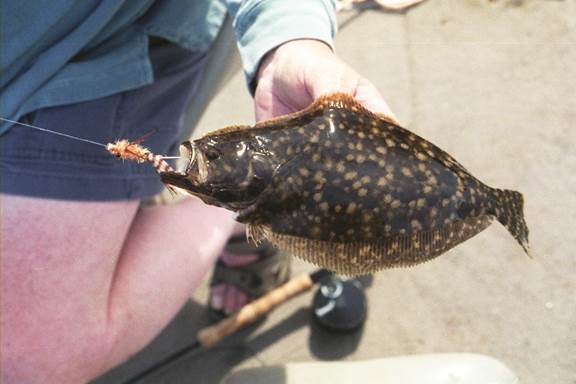
Flounder:
There are three species of Flounder found in the waters of Florida. The first species is the Summer Flounder [Paralichthys dentatus] and is the largest of the Flounder species with some exceeding twenty five pounds however they are only found in the extreme northeast Florida.
The Southern Flounder [Paralichthys lethostigma] is very common along the coastal waters of Florida. From the angler's perspective they average two to four pounds with eight to twelve pound fish available and they can reach twenty pounds and thirty six inches in length.
The Gulf Flounder [Paralichthys albigutta] are also found on both of the Florida coasts with the average fish being two to three pounds and topping out at around six pounds.
Flounder are a flatfish with both eyes on the same side of the head and they can change color to suit their surroundings. The spawning occurs in January and February offshore and with sixty days the young drift into the lagoons, estuaries, and tidal creeks. The best information says that they live for approximately twenty years. Adult Flounder can be found off the coast in deeper water however a great many inhabit the inshore waters and are available to the fly anglers.
In shallow water they prefer soft sandy or silty bottom near channels, along the edges of grass beds and are often found in the sandy openings in the middle to grass flats. They are also very tolerate to salinity levels and are found in many brackish water rivers and creeks, where often the angler's don't even realize they are present.
They are ambush predators which lay camouflaged on the bottom and striking their unwary prey with incredible quickness and they feed on fish spawn, small fish, shrimp and other small crustaceans. Once again various Clouser style minnows are very effective on Flounder. However any shrimp, crab or small minnow pattern fished close to the bottom are effective and I am often using a Sink Tip Line with a six foot leader and at times I am using full Sinking Lines and troll the imitations at very slow speeds.
Due to their flat shape they give a tough fight, however I do have a tip and that is once you have hooked a flounder keep steady pressure on the fish, don't pump up the fish as you fight them, just keep steady and constant pressure. If you try pumping up the fish trying get them off the bottom chance are you will lose them! Flounder is also a great fish to eat and many are taken for the table.
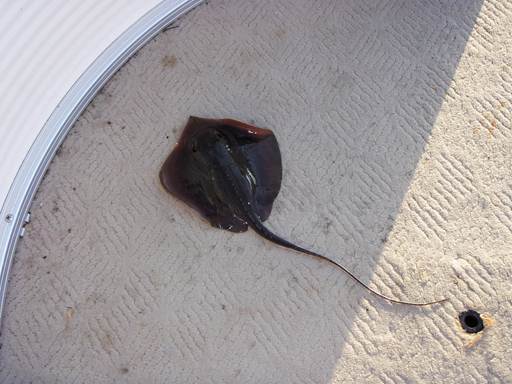
Stingrays:
Anyone that has spent any time at all in the saltwater has seen Stingrays sliding over the bottom in the shallow water and most anglers never target the "Rays". Now this may have something to with the venomous spine located on their tail and the fact that many anglers don't realize that they are excellent eating and they do in fact taste like Scallops. The angler usually catch small Rays with wingspans of two or three feet however they can reach 220 lbs and 79 inches in length however the average is more like 11 pounds and 24 inches.
In the waters of Florida there are two species they are the Atlantic Stingray [Dasyatis sabina] and the Southern Stingray [Dasyatis americana] and there is also the Clearnose Skate [Raja eglanteria] with is also very common in the shallow waters along the coast and like the Stingrays are very edible.
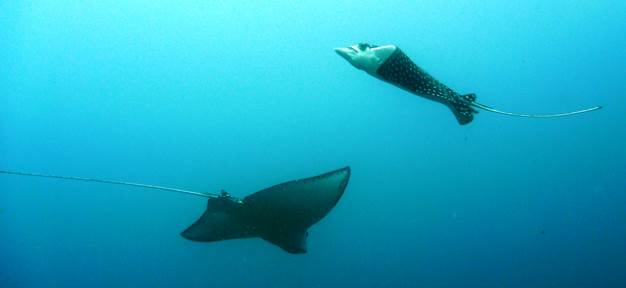
Now don't confuse these with the much larger Manta Ray or Spotted Eagle Ray. Any fly angler who hooks one of these will find it a short encounter.
Stingrays are common along the coast including the brackish and freshwater habitats. They can be found over sandy and silty bottoms and they are also found in the open ocean and around coral reefs. They feed on crustaceans, shellfish, worms and small minnows. Little is known about their life span but based on the date available it is placed at nine years.
I remember the first time I caught my first Ray and it was on a Clouser Minnow, I was aware of the spine on the tail but was very curious to exam this strange creature and I was aware that they were edible. Some say that the Stingray doesn't fight very well but I found that they were fun and very tasty.
Black Drum:
Black Drum [Pogonias cromis], are cousins to the Red Drum or more famously known as the Redfish and they are found in a wide range of habitats. They are found inshore in lagoons, estuaries, brackish water rivers, tidal creeks, around docks, bridge piling, in the deeper water along the channel edges and on the flats. They are also found along the surf line and close offshore.
They will school and can attain weights of 115 pounds, however anglers generally catch Black Drum in the 5 to 30 pound class and it is believed that their lifespan is 60 years.
Spawning occurs off shore in February through March and again in June and July. Upon hatching the fry move to the shoreline, estuaries and lagoons to gain food and protection from predators. They feed on crabs, shrimp, worms, small fish, and squid and they are highly sought after as a food fish by the conventional anglers.
Many of the bottom feeding fish that lack the glamour of the Bonefish or Redfish are often ignored by the fly anglers in the saltwater and this is a shame. It means that many anglers lose out on some great fishing.
Over the years I have caught my fair share of Black Drum, however I am always curious and willing to learn. One day I was south of Sebastian on the Indian River fishing in the area of the Wabasso Causeway Bridge and I noticed an angler who was fishing with live shrimp fishing by the bridge supports catching one fish after another. Being curious I dropped anchor to observe what this angler was doing and noticed that he was using a float cork and a live shrimp and what I was interested in was the distance of the cork above the live shrimp. I was able to see that the cork was placed four feet above the live shrimp, now I found that interesting as I knew that the water he was fishing in was nine feet deep, I filed away what I had seen, wrote a note in my journal and continued on with my fishing day.
About a week later I returned to the same location and was able to fish the water around the bridge where I had seen the angler with the live shrimp fishing and I tried several different shrimp imitations and various fly line without success. Then I decide to switch back to floating line and nine foot leader and try using strike indicators to control the depth of the imitations and after a bit of trial and error I began to catch Black Drum. Since that day I always have some form of strike indicator with me and I have found that often the Black Drum will move up in the water column to feed.
Now I will share some of the patterns that I use to catch the species I have discussed in this installment.
The number one pattern that I have found effective on both Flounder and Ray's or Skates are Super Clouser style minnows in various color combinations. These patterns have already been well covered in the Saltwater Chronicles.
However, I do have a couple of patterns that I use on Black Drum and on Flounder that I will share with you. These patterns were developed by mixing the components use by fly fishers and spin fishers; some will find them exciting others will claim that they are not real flies, but that discussion will be addressed at another time and place.
Many fly tiers across the country have experiment with various soft plastic used by the Bass, Walleye and saltwater anglers use with various jigs, crankbaits and the like, the innovative fly tier have long played with these materials. Years ago I found the "Fly Tails" in the Cabela's Catalog and gave them a try and the following is the result of that experimentation. This pattern has proven effective on Rays, Pompano, and Flounder.
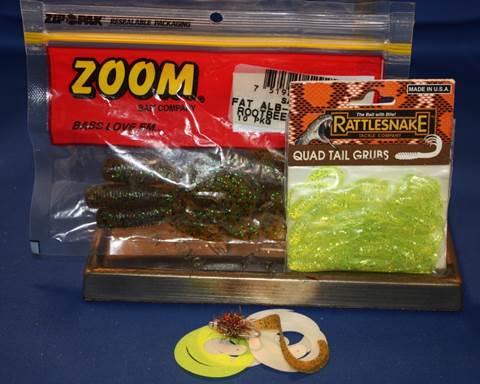

Root Beer & Pumpkin Grub
- Hook: Mustad 3407 Sizes: 4-8
- Thread: Brown 6/0
- Eyes: Dumb-bell type, painted Red with Black centers, coated lightly with five minute epoxy for durability place the eyes on the top of the hook shank so the hook will invert in the water to ride hook point up.
- Tails: Cabela's Fly Tails, Pumpkin either two inch or two and quarter inch. These tails come in packs of twenty and cost around $4.50 a pack.
- Head: Root Beer Estaz or Crystal chenille tied tightly in a figure eight around the eyes
This pattern is easy and quick to construct and the action with the tail is incredible remember not to retrieve this pattern to fast, skittering and twitching across the bottom is much more effective.
The next pattern is the Spoony Tan Shrimp and the Fly in photograph shows a down eyed stainless steel saltwater hook. I am unsure of what this hook is as I received it in a box of materials from an estate of someone who had passed on to fish the waters in the sky. But I believe the hook is a Partridge CS11/2 Stainless Steel size four. The photograph is of the original proto type and I now tie this pattern on Mustad 34007 or 34011.
For those fly tiers who wish to experiment with spoon blades I suggest looking in the Cabela's Tackle Craft Catalog where the variety of spinner blades is very impressive and I use many different styles in the construction of some unique and innovative patterns. Now none of them really work but they sure look good and generate plenty of conversation!
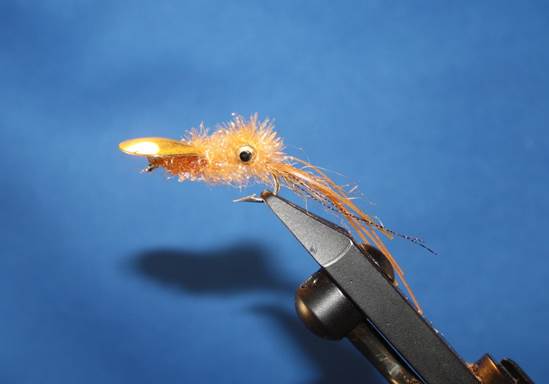
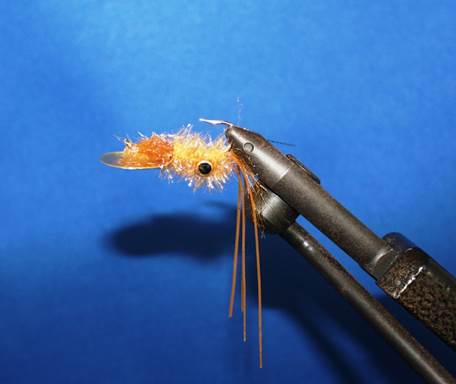
Spoony Tan Shrimp:
- Hook: Mustad 34007 or 34011 Sizes: 2/0-6
- Thread: Tan 6/0
- Tails: Farrar's Flash Blend Redfish Fibers, tied down the bend of the hook
- Antennae: Two strands of Black Krystal Flash tied 1-1/2 times the length of the hook and to either side of the tail
- Eyes: Dumb-bell type painted Tan with Black centers, tied on the top of the hook shank so the pattern will invert and ride hook point up in the water
- Legs: Four strands of Pumpkin Fleck Sili-legs, two per side tied on either side of the eyes and stagger cut so each leg is a different length
- Head: Tan Crystal Flash Chenille tightly wrapped around the eyes
- Body: Tan Crystal Flash Chenille or Estaz
- Spinner Blade: Gold metal spoon blade, the spinner blade is placed on hook shank with concave side of the blade facing forward, once half of the body is completed this place the blade on the top of hook shank and press down, building a base with thread and then continue wrapping the body. Then blade is held in place by placing epoxy on the forward half of the hook shank and then the blade is pressed tight to the body. Once it has dried a second coat of epoxy is applied.
This pattern can also be tied in a shrimp grey or olive and is an excellent pattern for Black Drum.
You are only limited by your own desires to be creative at the tying vise and there are still many innovative and effective patterns yet to be designed for saltwater fly fishing.
Enjoy & Good Fishin'
| Sysadmin Note |
|---|
| Part 19 can be found here |
